
Wine Culture and Information since 2002 - Volume 22
 Wine Culture and Information since 2002 - Volume 22 |
|
Issue 55, September 2007 |
Contents |
|
|
The Hot Vintage 2007 |
|
A hot weather like the one of summertime 2007 was not seen since many years, not only in Italy, but also in other countries of the world. The worldwide climate is changing with pretty bizarre manifestations - unusual for sure as well as preoccupying - and lately this is not considered as a newsworthy event anymore, although we should at least ask ourselves about the reasons responsible for these changes. In Italy temperature has also raised over 40° C, in particular in Southern regions, with pretty obvious results, according to a viticultural point of view. The ripening of grape, and therefore harvesting, took place in advance than past years, even of thirty days, something particularly happened in many areas of South Italy. Harvesting grapes earlier than usual is however something happened in every region in Italy, from North to South, with an average of twenty days in advance than the previous years. The quality of grapes in Italian vineyards, according to the estimates of Confederazione Italiana Agricoltori (Italian Confederation of Agriculturists), is very good, also thanks to the favorable conditions happened in springtime. However the arrive of hot weather and the high solar irradiation which took place during summertime, have strongly reduced maturation times therefore forcing viticulturists to begin harvesting in order to keep the good quality of grapes. With these conditions, and while waiting for the usual confirmations which will arrive the next year, vintage 2007 will be therefore remembered for its good quality and for the early harvesting. According to the estimates of Confederazione Italiana Agricoltori, vintage 2007 will be characterized by a lower production than 2006, with a lowering in production of about 10%. In fact, in 2006 were produced in Italy fifty millions of hectoliters of wine, whereas in 2007 it is expected a production of “just” forty-five millions. It seems the lowering in production is something also expected in other countries of the world besides Italy. It will be in fact expected lowering in production also in other European countries as well as in the countries of the Southern hemisphere of the world, such as Australia and New Zealand. The lowering of production - according to Confederazione Italiana Agricoltori - could cause a potential raising of prices of wine, a prevision that, of course, we wish not to happen. In the rich speculative scene of the world of wine, also considering the not so good economic conditions of this period, a raising in prices would certainly cause the lowering of the sales for quality wine. This condition would certainly favor the sale of “bulk wines” and of ordinary quality wines that, taking advantage of their lower and more accessible price, will therefore keep their solid position in the market. The most interesting news is of course the one concerning the quality of vintage 2007, something that - to tell the truth - we have always heard at the beginning of past years' harvesting. Whether this is something caused by merely speculative and economic reasons, this does not count that much, for the moment we certainly welcome with pleasure this prevision of which we will seek a confirmation - or a denial - when 2007 wines will be finally available and ready to be poured in glasses. Vintage 2007 will be among the most early ones in the last thirty years, earlier than the one of 2003 which, because of the hot weather of that summertime, forced viticulturists to harvest grapes in advance of some weeks. Wines of vintage 2003, although they were of good quality, besides of the high temperatures recorded during that summer, they also suffered from early maturation of grapes and from drought, in particular white berried grapes. Things should however go differently in 2007, mainly because in this year there was no drought. Despite winter and part of spring have been characterized by a scarce presence of rains, the providential rainfalls during June have provided vines the supply of water they need. The hot weather of July has therefore allowed the vegetative development of vines, therefore causing an early maturation of grapes. Whether, in general terms, the summer of 2007 has been very torrid and in many regions vineyards have subjected to hot sun rays, it should also be remembered in some areas of Northern Italy, because of a sudden bad weather which took place in July, part of cultures have been severely damaged, including vineyards. In some areas of Italy, besides the heat, it seems there were other problems to bother viticulturists, such as attacks of downy mildew and oidium, in particular in Sicily. For this reason viticulturists had to adopt specific measures, unfortunately not effective in many cases to limit damages. As for the exceptionality of torrid temperatures of summer 2007, it should however be considered this phenomenon is taking place since many years, also because of a consequence of the evident and preoccupying changes of worldwide climate conditions. In fact, in the last years the average temperatures were higher than past years, with the result of reducing the vegetative period of vines. For this reason the maturation of grapes is taking place in advance than past years, therefore forcing viticulturists to do early harvesting. Recently, Attilio Scienza - professor of Viticulture at the University of Milan - has said in the last years harvesting tended to be earlier than usual times. According to professor Attilio Scienza, in case this phenomenon will continue, viticulturists will be forced to plant - as well as to create - grape varieties capable of adapt themselves to these climate changes. A scenery which is not good, of course, and that could also cause the extinction or a change of the typical varieties in each territory. Of course this is something no one wishes, while hoping man - a presumptuous being convinced to be omnipotent and with an absolute intelligence - will soon understand the consequences of his deplorable actions, most of the times speculative, fool and harmful. Welcome vintage 2007 with our best wishes for a great success!
|
||||
Comparing Montepulciano d'AbruzzoThe great red berried grape emblem of viticulture and enology of Abruzzo is since many years considered among the best expressions of Italian enology and great red wines |
|
Montepulciano certainly is one of the most famous and important red berried grapes of Italy. Mainly common in the region of Central Italy, Montepulciano is mainly identified with Abruzzo, the region in which it is also the most common and cultivated red variety. It is right in this region which is made one of the most renowned wines produced with this grape - Montepulciano d'Abruzzo - which in the last recent years, also thanks to the efforts and the good results achieved by producers, was successful in becoming among the most important wines of Italy, known everywhere in the world. Nevertheless, up to some tens of years ago, Montepulciano was considered, and not only in Abruzzo, a grape capable of making “ordinary” wines lacking of interesting qualities according to an organoleptic and enological point of view. As it happened for other grapes, the tenacity of producers, convinced with the grapes of their land was possible to make great wines, as well as the use of quality wine making techniques, also Montepulciano made a miracle and in few years it reached the top of Olympus. Montepulciano is also found in vineyards of Marches - with which it is produced, among the many, Rosso Conero and Rosso Piceno - Molise, Apulia, Umbria, Latium and, marginally, Apulia, Sardinia and Calabria. Famous for its excellent coloring qualities and for the quantity of extracts, Montepulciano has been used for years as a bulk grape, destined to give color and body to other wines, also thanks to its good production qualities. For this reason and for many years, Montepulciano has been cultivated with low quality principles, as its usage was mainly destined to the mixing with other grapes, once considered more noble. Indeed, when quality viticultural concepts are adopted, Montepulciano is capable of giving great wines, rich, thick and robust, rich in aromas that with time can give complexity to the nose of any careful wine taster. Thanks to the quantity of polyphenols and alcohol, quality wines produced with Montepulciano can in fact age in the bottle for many years, even more than 10 years in the best cases.
|
|
Montepulciano is a grape which tends to ripe later than other varieties, therefore its cultivation can be easily adapted to the areas with a mild climate also at the end of summertime and at the beginning of autumn. This characteristic in fact determines its geographic spreading, typically central and southern Italy. Among the many expressions of Montepulciano, the most famous wine certainly is the one produced in Abruzzo, whose wines will be the protagonists of our comparative tasting. Montepulciano d'Abruzzo, according to the production disciplinary, can be released for consumption after March 1st following harvesting, or after at least two years of aging for the “reserve” style. Montepulciano d'Abruzzo is generally aged in cask, however the aging in barrique is also frequent. Thanks to the quantity of sugar contained in this grape, Montepulciano d'Abruzzo is a wine with a pretty high alcohol by volume, sometimes higher than 14%.
Our comparative tasting will examine three Montepulciano d'Abruzzo wines in order to study the organoleptic qualities of this grape and the influence of the aging in wood according to the style and the choices done by each producer. The three wines of our comparative tasting will also allow the study of the huge wine making potentials of Montepulciano and its robust body. The first wine of our comparative tasting is Marramiero's Montepulciano d'Abruzzo Inferi, produced with mixed techniques, of which 24 months in steel tanks and 18 months in barrique. The second wine is Illuminati's Montepulciano d'Abruzzo Zanna, completely aged for 26 months in cask. The last wine of our comparative tasting is Masciarelli's Montepulciano d'Abruzzo Villa Gemma, aged for 36 months, of which 24 in barrique. The three wines will be served at the temperature of 18° C (65° F) and we will use - as usual - three ISO tasting glasses.
|
||||||||
|
Despite in past times Montepulciano was not considered that much for the production of mono varietal wines, however it has always been blended with all those grapes that - despite of their fame - were not capable of making wines rich in color. Montepulciano in fact has a good quantity of coloring substances, therefore in its wines transparency will be pretty low and the color will show very intense and deep hues. During its youth, wines produced with Montepulciano will clearly show this quality, with intense and deep ruby red color and evident nuances of purple red. Whereas purple red nuances will tend to disappear within two or three years - according to the quality of grapes and of wine making techniques - Montepulciano will show evident ruby red hues which will change into garnet red after some years of aging in bottle, whereas the nuance will change into garnet red color just after some years of aging. The first wine of which we will examine appearance is Marramiero's Montepulciano d'Abruzzo Inferi. By keeping the glass tilted over a white surface - a cloth or a sheet of paper will do - we will begin the evaluation of the intensity of color by observing the liquid mass at the base of the glass. This first wine will let us understand the appearance qualities of Montepulciano: pretty low transparency and a very intense ruby red color. By observing nuances - at the edge of the liquid mass towards the opening of the glass - we will notice the same color. Also the evaluation of the second wine - Illuminati's Montepulciano d'Abruzzo Zanna - confirms the appearance qualities of Montepulciano: low transparency, deep ruby red color and ruby red nuances. The transparency of the third wine, Masciarelli's Montepulciano d'Abruzzo Villa Gemma, is even lower than the previous two wines, with a very deep ruby red color and evident ruby red nuances.
|
|
The olfactory profile of Montepulciano is mainly characterized by the world of red and black berried fruits, as well as flowers, in particular in young wines. Thanks to its qualities, Montepulciano is generally aged in cask - frequently the barrique as well - however in some cases it is preferred to age it in inert containers, such as steel and cement. The choice of the container used for aging, of course, largely influences on Montepulciano's olfactory qualities, therefore contributing to the development of tertiary aromas. The aging of Montepulciano d'Abruzzo is generally made on cask and barrique, therefore in this wine we will frequently find tertiary aromas derived from wood. Black cherry and plum are the most typical and frequent aromas of Montepulciano d'Abruzzo, whereas the main representative of the world of flowers is violet. Among other fruit aromas which can be found are mentioned blueberry, blackberry and raspberry, whereas, as for flowery aromas, it is sometimes possible to find cyclamen. The first wine of which we will examine aromas in our comparative tasting is Marramiero's Montepulciano d'Abruzzo Inferi. By holding the glass in vertical position and without swirling, we will proceed with the first smell in order to evaluate opening aromas. From the glass will emerge aromas of black cherry and plum - the typical opening of Montepulciano d'Abruzzo - to which will follow the aroma of blackberry. Let's now swirl the glass in order to favor the volatilization of the other aromatic components and then we will proceed with a second smell. The aromatic profile of the wine will be completed by perceptions of blueberry and violet, followed by an interesting sequence of tertiary aromas of vanilla, cocoa, tobacco, licorice, cinnamon, mace and a pleasing hint of black pepper. Despite this wine is aged for 24 months in steel tanks, the following 18 months of aging in barrique have contributed - with balance and harmony - to the development of tertiary aromatic qualities. Let's now proceed with the evaluation of the second wine of our comparative tasting: Illuminati's Montepulciano d'Abruzzo Zanna. By holding the glass in vertical position, we will proceed with the evaluation of opening aromas which will be characterized by aromas of black cherry, plum and violet, also in this case very typical of Montepulciano. After having swirled the glass, we will proceed with a second smell in order to complete the olfactory profile of the wine. From the glass will be perceived aromas of blueberry and blackberry to which will follow tertiary aromas of vanilla, cinnamon, cocoa, tobacco, licorice as well as a pleasing hint of black pepper, also in this case fruit of the aging in cask. The opening of the third wine - Masciarelli's Montepulciano d'Abruzzo Villa Gemma - is characterized by black cherry, plum, blackberry and violet to which will follow, after having swirled the glass, aromas of black currant and blueberry completed by aromas of vanilla, cinnamon, cocoa, pink pepper, tobacco, licorice, leather, mace and a pleasing balsamic hint of menthol, result of the aging in cask for 24 months.
|
||||
|
Wines produced with Montepulciano, or better to say, with Montepulciano grapes from quality vineyards, are always characterized by a pretty robust structure. In fact, it is not rare to find a Montepulciano d'Abruzzo with powerful and robust bodies, a characteristic which is also produced by the aging in cask or barrique. The concentration of Montepulciano d'Abruzzo - produced with quality criteria - will be one of the first characteristics to be perceived to the mouth, with a pretty evident astringency. Another gustatory characteristic of Montepulciano d'Abruzzo is represented by its alcohol by volume, generally being pretty high - it is not rare to find a wines with more than 14% - a characteristic which is also useful for reaching a good balance with structure and astringency. The persistence of Montepulciano d'Abruzzo is generally very good and it is not rare to find wines with pretty long taste-olfactory persistence. The first wine we will examine in the gustatory phase is Marramiero's Montepulciano d'Abruzzo Inferi. The attack of this Montepulciano confirms the typical qualities of this wine: an evident astringency well balanced by alcohol and roundness, as well as an excellent correspondence to the aromas perceived by the nose, in particular black cherry and plum. The attack of the second wine - Illuminati's Montepulciano d'Abruzzo Zanna - is characterized by a pretty evident astringency and body, however well balanced by alcohol. Despite the robust attack, it should also be noticed the good and pleasing roundness of this wine. Full body is also what we perceive in the last wine of our comparative tasting - Masciarelli's Montepulciano d'Abruzzo Villa Gemma - to which is also perceived an evident astringency well balanced both by roundness and alcohol, in this case being of 14.5%. It should be noticed how in all the three wines it is possible to perceive an excellent correspondence to the nose and a good roundness given by the aging in cask or barrique.
|
|
Montepulciano d'Abruzzo is a wine generally having a very good taste olfactory persistence, very long persistence in case of wines produced with quality criteria. The finish of Marramiero's Montepulciano d'Abruzzo Inferi is persistent, leaving in the mouth evident and clean flavors of black cherry, plum and blackberry, very agreeable. Also the finish of Illuminati's Montepulciano d'Abruzzo Zanna is persistent and very clean, leaving in the mouth the typical flavors of black cherry and plum to which also follows the flavor of blueberry. The finish of Masciarelli's Montepulciano d'Abruzzo Villa Gemma is very persistent and robust, leaving in the mouth long and clean flavors of black cherry and plum - once again, typical and identifying qualities of Montepulciano - to which follows a pleasing and clean flavor of blackberry. The history of Montepulciano d'Abruzzo, which certainly has endless and important pages still to be written, can be defined as a “happy end” tale. Once considered as an ordinary wine - this is how it was defined more than 20 years ago - today Montepulciano d'Abruzzo is one of those important wines distinguishing Italian enology in the world.
|
Wines of the Month |
|
|
|
Score legend Prices are to be considered as indicative. Prices may vary according to the country or the shop where wines are bought |

|
|
Valpolicella Classico Superiore Vigneto Sant'Urbano 2004 |
|
| Speri (Veneto, Italy) | |
| Grapes: Corvina (70%), Rondinella (20%), Molinara (5%) | |
| Price: € 16.00 | Score: |
| This wine shows a brilliant ruby red color and nuances of garnet red, moderate transparency. The nose reveals intense, clean, pleasing and refined aromas that start with hints of blackberry, black cherry and plum followed by aromas of raspberry, blueberry, violet, vanilla, chocolate, mace and cinnamon. The mouth has good correspondence to the nose, a tannic attack and however balanced by alcohol, good body, intense flavors, agreeable. The finish is persistent with flavors of blackberry, plum and black cherry. Valpolicella Classico Superiore Vigneto Sant'Urbano ages for 18 months in cask. | |
| Food Match: Roasted meat, Braised and stewed meat with mushrooms, Hard cheese | |
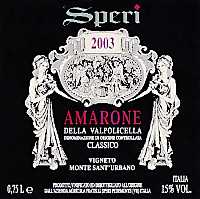
|
|
Amarone della Valpolicella Classico Vigneto Sant'Urbano 2003 |
|
| Speri (Veneto, Italy) | |
| Grapes: Corvina (70%), Rondinella (25%), Corvinone (5%) | |
| Price: € 45.00 | Score: |
| Amarone della Valpolicella Classico Vigneto Sant'Urbano shows an intense ruby red color and nuances of garnet red, little transparency. The nose reveals intense, clean, pleasing, refined and elegant aromas which start with hints of blackberry, plum and black cherry followed by aromas of dried violet, blueberry, tobacco, vanilla, menthol, pink pepper, chocolate, mace and clover. The mouth has good correspondence to the nose, a tannic attack and pleasing roundness, however balanced by alcohol, full body, intense flavors, agreeable. The finish is persistent with flavors of blackberry, black cherry and plum. A well made wine. This Amarone ages for 30 months in cask. | |
| Food Match: Game, Roasted meat, Stewed and braised meat, Hard cheese | |
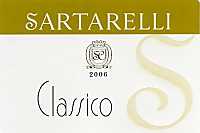
|
|
Verdicchio dei Castelli di Jesi Classico 2006 |
|
| Sartarelli (Marches, Italy) | |
| Grapes: Verdicchio | |
| Price: € 7.00 | Score: |
| This wine shows a brilliant greenish yellow color and nuances of greenish yellow, very transparent. The nose reveals intense, clean and pleasing aromas that start with hints of pear, apple and peach followed by aromas of almond, hawthorn, broom and pineapple. The mouth has good correspondence to the nose, a crisp attack and however balanced by alcohol, good body, intense flavors. The finish is persistent with flavors of pear, peach and almond. | |
| Food Match: Pasta and risotto with fish and crustaceans, Dairy products, Eggs, Fried fish | |
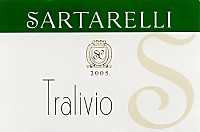
|
|
Verdicchio dei Castelli di Jesi Classico Superiore Tralivio 2005 |
|
| Sartarelli (Marches, Italy) | |
| Grapes: Verdicchio | |
| Price: € 12.00 | Score: |
| Tralivio shows a pale straw yellow color and nuances of greenish yellow, very transparent. The nose denotes intense, clean, pleasing and refined aromas which start with hints of apple, hawthorn and almond followed by aromas of pineapple, broom, pear, elder, plum and hints of mineral. The mouth has good correspondence to the nose, a crisp attack and however balanced by alcohol, good body, intense flavors, agreeable. The finish is persistent with flavors of apple, plum and almond. | |
| Food Match: Broiled fish, Roasted white meat, Fish soups | |
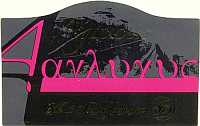
|
|
Aglucus 2003 |
|
| Colle di San Domenico (Campania, Italy) | |
| Grapes: Aglianico | |
| Price: € 25.00 | Score: |
| Aglucus shows an intense ruby red color and nuances of garnet red, little transparency. The nose denotes intense, clean, pleasing and refined aromas that start with hints of black cherry, plum and blackberry followed by aromas of blueberry, violet, vanilla, tobacco, pink pepper, carob and cinnamon. The mouth has good correspondence to the nose, a tannic attack and however balanced by alcohol, good body, intense flavors, agreeable. The finish is persistent with flavors of plum, black cherry and blackberry. Aglucus ages for 12 months in cask followed by at least 6 months of aging in bottle. | |
| Food Match: Roasted meat, Braised and stewed meat with mushrooms, Hard cheese | |
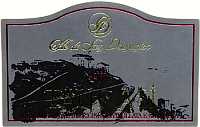
|
|
Taurasi Riserva 1999 |
|
| Colle di San Domenico (Campania, Italy) | |
| Grapes: Aglianico | |
| Price: € 20.50 | Score: |
| This Taurasi Riserva shows a brilliant ruby red color and nuances of garnet red, moderate transparency. The nose reveals intense, clean, pleasing and refined aromas which start with hints of black cherry, plum and violet followed by aromas of blackberry, blueberry, vanilla, tobacco, licorice, carob and menthol. The mouth has good correspondence to the nose, a tannic attack and however balanced by alcohol, good body, intense flavors. The finish is persistent with flavors of black cherry, plum and blackberry. This Taurasi Riserva ages for 3 years in cask followed by 12 months of aging in bottle. | |
| Food Match: Game, Roasted meat, Braised and stewed meat, Hard cheese | |
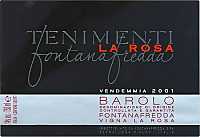
|
|
Barolo Fontanafredda Vigna La Rosa 2001 |
|
| Fontanafredda (Piedmont, Italy) | |
| Grapes: Nebbiolo | |
| Price: € 40.70 | Score: |
| Barolo Fontanafredda Vigna La Rosa shows a brilliant ruby red color and nuances of brick red, moderate transparency. The nose reveals intense, clean, pleasing and refined aromas that start with hints of cherry, plum and rose followed by aromas of violet, strawberry, raspberry, vanilla, tobacco, chocolate, cinnamon and menthol. The mouth has good correspondence to the nose, a tannic attack and pleasing crispness, however balanced by alcohol, full body, intense flavors. The finish is persistent with flavors of cherry, plum and raspberry. Barolo Fontanafredda Vigna La Rosa ages for 12 months in barrique followed by 12 months of aging in cask and 12 months of aging in bottle. | |
| Food Match: Game, Roasted meat, Braised and stewed meat, Hard cheese | |
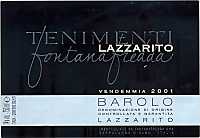
|
|
Barolo Lazzarito Vigna La Delizia 2001 |
|
| Fontanafredda (Piedmont, Italy) | |
| Grapes: Nebbiolo | |
| Price: € 44.00 | Score: |
| Barolo Lazzarito Vigna La Delizia shows a brilliant ruby red color and nuances of brick red, moderate transparency. The nose reveals intense, clean, pleasing, refined and elegant aromas which start with hints of cherry, violet and plum followed by aromas of raspberry, rose, tobacco, vanilla, mace, chocolate, licorice, cinnamon, white pepper and menthol. The mouth has excellent correspondence to the nose, a tannic attack and pleasing crispness, however balanced by alcohol, full body, intense flavors, agreeable roundness. The finish is very persistent with long flavors of cherry, plum and raspberry. A well made wine. Barolo Lazzarito Vigna La Delizia ages for 12 months in barrique followed by 12 months of aging in cask and 12 months of aging in bottle. | |
| Food Match: Game, Roasted meat, Braised and stewed meat, Hard cheese | |
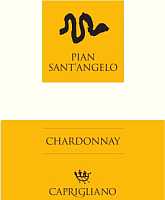
|
|
Pian Santangelo 2006 |
|
| Caprigliano (Latium, Italy) | |
| Grapes: Chardonnay | |
| Price: € 6.50 | Score: |
| The wine shows a pale straw yellow color and nuances of greenish yellow, very transparent. The nose denotes intense, clean and pleasing aromas which start with hints of banana, pear and pineapple followed by aromas of acacia, apple and broom. The mouth has good correspondence to the nose, a crisp attack and however balanced by alcohol, good body, intense flavors. The finish is persistent with flavors of banana, apple and pineapple. This wine ages in steel tanks. | |
| Food Match: Fried fish, Pasta and risotto with fish, Sauteed white meat | |
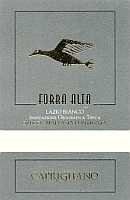
|
|
Forra Alta 2006 |
|
| Caprigliano (Latium, Italy) | |
| Grapes: Greco Bianco (50%), Malvasia del Lazio (50%) | |
| Price: € 6.00 | Score: |
| Forra Alta shows an intense golden yellow color and nuances of straw yellow, very transparent. The nose reveals intense, clean, pleasing and refined aromas that start with hints of peach, apple and pear followed by aromas of hawthorn, citrus fruits, plum and anise. The mouth has good correspondence to the nose, a crisp attack and pleasing roundness, however balanced by alcohol, good body, intense flavors. The finish is persistent with flavors of apple, plum and peach. | |
| Food Match: Mushrooms soups, Stuffed pasta with meat, Roasted white meat, Roasted fish | |
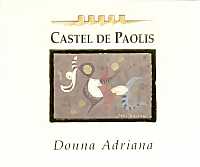
|
|
Donna Adriana 2006 |
|
| Castel De Paolis (Latium, Italy) | |
| Grapes: Malvasia Puntinata, Viognier, Sauvignon Blanc | |
| Price: € 16.00 | Score: |
| Donna Adriana shows a brilliant greenish yellow color and nuances of greenish yellow, very transparent. The nose reveals intense, clean, pleasing and refined aromas that start with hints of peach, pear and nettle followed by aromas of pineapple, banana, litchi, gooseberry, apple and broom. The mouth has good correspondence to the nose, a crisp attack and however balanced by alcohol, good body, intense flavors, agreeable. The finish is persistent with flavors of peach, pear and pineapple. Donna Adriana ages in steel tanks. | |
| Food Match: Pasta with mushrooms and fish, Fried fish, Stewed fish, Sauteed white meat | |
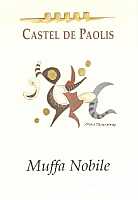
|
|
Muffa Nobile 2006 |
|
| Castel De Paolis (Latium, Italy) | |
| Grapes: Sémillon (80%), Sauvignon Blanc (20%) | |
| Price: € 20.00 - 500ml | Score: |
| Muffa Nobile shows a brilliant amber yellow color and nuances of amber yellow, transparent. The nose reveals intense, clean, pleasing and refined aromas that start with hints of dried apricot, date and raisin followed by aromas of peach jam, quince jam, candied fruits, dried fig, almond, honey, vanilla and musk. The mouth has good correspondence to the nose, a sweet and round attack, however balanced by alcohol, good body, intense flavors, pleasing crispness. The finish is persistent with flavors of raisin, dried apricot and honey.Muffa Nobile is produced with grapes completely affected by Botrytis Cinerea. | |
| Food Match: Hard and piquant cheese, Desserts | |
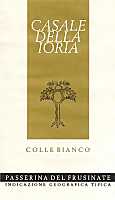
|
|
Colle Bianco 2006 |
|
| Casale della Ioria (Latium, Italy) | |
| Grapes: Passerina | |
| Price: € 5.00 | Score: |
| Colle Bianco shows a brilliant straw yellow color and nuances of straw yellow, very transparent. The nose reveals intense, clean and pleasing aromas that start with hints of apple, hawthorn and almond followed by aromas of broom and plum. The mouth has good correspondence to the nose, a crisp attack and pleasing roundness, however balanced by alcohol, good body, intense flavors. The finish is persistent with flavors of apple, plum and almond. The finish is pretty persistent with flavors of apple, plum and almond. Colle Bianco ages for 4 months in steel tanks. | |
| Food Match: Fish and vegetables appetizers, Risotto with fish, Boiled fish | |

|
|
Frascati Superiore Linea Storica 2006 |
|
| Casale Mattia (Latium, Italy) | |
| Grapes: Malvasia di Candia, Malvasia Bianca, Trebbiano Giallo, Bombino, Bellone | |
| Price: € 10.00 | Score: |
| Frascati Superiore Linea Storica shows a pale straw yellow color and nuances of greenish yellow, very transparent. The nose denotes intense, clean, pleasing and refined aromas that start with hints of gooseberry, apple and pear followed by aromas of hawthorn, broom, plum and hazelnut. The mouth has good correspondence to the nose, a crisp attack and however balanced by alcohol, good body, intense flavors, pleasing roundness. The finish is persistent with flavors of apple, gooseberry and plum. Frascati Superiore Linea Storica ages in steel tanks. | |
| Food Match: Fried fish, Pasta with fish, Roasted fish, Roasted white meat | |
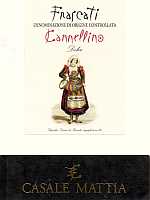
|
|
Frascati Cannellino 2006 |
|
| Casale Mattia (Latium, Italy) | |
| Grapes: Malvasia di Candia, Malvasia Bianca, Trebbiano Giallo, Bombino | |
| Price: € 7.00 - 500ml | Score: |
| Frascati Cannellino shows a brilliant straw yellow color and nuances of greenish yellow, very transparent. The nose denotes intense, clean, pleasing and refined aromas that start with hints of apple, hawthorn and almond followed by aromas of candied fruits, honey, pear and plum. The mouth has good correspondence to the nose, a sweet and crisp attack, however balanced by alcohol, good body, intense flavors, agreeable roundness. The finish is persistent with flavors of apple, plum and honey. | |
| Food Match: Fruit desserts | |
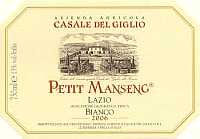
|
|
Petit Manseng 2006 |
|
| Casale del Giglio (Latium, Italy) | |
| Grapes: Petit Manseng | |
| Price: € 8.40 | Score: |
| This Petit Manseng shows an intense greenish yellow color and nuances of greenish yellow, very transparent. The nose denotes intense, clean, pleasing and refined aromas that start with hints of apple, pineapple and nettle followed by aromas of peach, pear, mango, grapefruit, broom and elder. The mouth has good correspond to the nose, a crisp attack and however balanced by alcohol, good body, intense flavors, agreeable. The finish is persistent with flavors of pineapple, apple and peach. | |
| Food Match: Pasta and risotto with crustaceans and mushrooms, Stewed fish, Broiled crustaceans | |
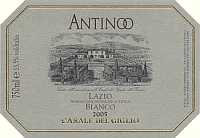
|
|
Antinoo 2005 |
|
| Casale del Giglio (Latium, Italy) | |
| Grapes: Chardonnay (66%), Viognier (34%) | |
| Price: € 9.90 | Score: |
| Antinoo shows a brilliant straw yellow color and nuances of straw yellow, very transparent. The nose reveals intense, clean, pleasing and refined aromas that start with hints of banana, apple and plum followed by aromas of hazelnut, vanilla, mineral, hawthorn, pear and grapefruit. The mouth has good correspondence to the nose, a crisp attack and however balanced by alcohol, good body, intense flavors, agreeable roundness. The finish is persistent with flavors of banana, apple and plum. Antinoo ages in barrique for 8 months followed by 12 months of aging in bottle. | |
| Food Match: Stuffed pasta with mushrooms, Roasted fish, Roasted white meat | |
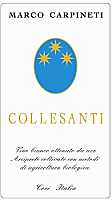
|
|
Collesanti 2006 |
|
| Marco Carpineti (Latium, Italy) | |
| Grapes: Arciprete Bianco Bellone | |
| Price: € 6.20 | Score: |
| Collesanti shows a pale straw yellow color and nuances of greenish yellow, very transparent. The nose denotes intense, clean and pleasing aromas which start with hints of peach, pineapple and apple followed by aromas of hazelnut, hawthorn, pear and broom. The mouth has good correspondence to the nose, a crisp attack and however balanced by alcohol, good body, intense flavors. The finish is persistent with flavors of pineapple, peach and apple. Collesanti ages in steel tanks. | |
| Food Match: Sauteed fish, Pasta and risotto with fish and crustaceans, Sauteed white meat | |
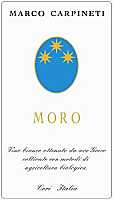
|
|
Moro 2006 |
|
| Marco Carpineti (Latium, Italy) | |
| Grapes: Greco Bianco | |
| Price: € 8.00 | Score: |
| Moro shows a pale straw yellow color and nuances of greenish yellow, very transparent. The nose reveals intense, clean, pleasing and refined aromas that start with hints of apple, plum and peach followed by aromas of hawthorn, pineapple, pear, broom and almond. The mouth has good correspondence to the nose, a crisp attack and however balanced by alcohol, good body, intense flavors. The finish is persistent with flavors of apple, plum and peach. Moro ages in steel tanks. | |
| Food Match: Fried fish, Pasta and risotto with fish and crustaceans, Sauteed fish | |
News |
|
In this section are published news and information about events concerning the world of wine and food. Whoever is interested in publishing this kind of information can send us a mail to our address.
|
FigComing from Asia, fig is a plant typical in subtropical climate regions and it is now common in most of the countries of the Mediterranean area |
|
Common fig (Ficus Carica) belongs to the family of Moraceae, it is a typical plant in subtropical climates and since immemorial times spread also in the Mediterranean area. The name “Carica” seems to refer to a region of Lesser Asia - Caria - which is located in Anatolia, the area where today is found Turkey. Appreciated since biblical times, fig leaves were also the first “garment” of history. It is in fact read in Genesis 3,7 «And the eyes of them both were opened, and they knew that they were naked; and they sewed fig leaves together, and made themselves aprons». Fig is a plant very resistant to drought, it grows in the same areas of vine and olive trees, however it cannot stand to temperatures lower than -10° C, clayey and excessively humid soils. Fig prefers warm climates, limestone soils, stony and well drained. The plant has a pretty large root system and very invasive, particularly effective in searching water. In case you are planning of building a garden, before choosing the right place for a fig tree, you should consider its roots can easily penetrate tanks, pipes and basements. The robust gray trunk let the plant to reach up to eight meters in height. There are two subspecies: ficus carica sativa (common fig) and ficus carica caprificus (caprifig or wild fig). Common fig bears two types of fruits, one forming in autumn and riping in late springtime, and another forming in springtime and riping in summertime. The varieties of caprifig are limited to some tens of types, whereas the varieties of common fig count some hundreds different types; many of them being very ancient, including least known local varieties. The productivity of a tree depends on climate, humidity and the soil in which it grows. In a loose soil, fresh and deep a fig tree can also make 4 or 5 quintals of figs, whereas in a stony soil it rarely makes more than one kilogram. Fig tree begins to bear fruits after the fifth year of life and continues up to the sixtieth, when the plant rapidly dies.
|
|
The discovery of researchers Ofer Bar-Yosef of Harvard University and Mordechai E. Kislev and Anat Hartmann of Bar-Ilan University, seems to rewrite the origins of agriculture. The discovery was made in Israel, in an archaeological site located in the low valley of Jordan river, few kilometers north from Jericho and called “Gigal I”, inhabited about 11,400 years ago. These researchers discovered in this place nine small figs and 313 small part of fruits carbonized by time, however, according to other researchers, there were indeed prepared in order to be consumed later. The discovery proves figs were cultivated about five thousands years before than it was believed and one thousand years before wheat and barley.
The origin of fig seems to be from Western Asia or, according to others, from the Middle East. It is however a plant with very ancient origins, very appreciated by all the people of the past, not only for its particular taste, but also for its symbolic value. History is in fact rich of artistic, religious and literary witnesses about fig. In the Old Testament it is frequently mentioned as a symbol of abundance. In India it is considered as a sacred tree, Asvattha (cosmic tree), however it should be noticed it is another type of plant, “Ficus Religiosa”. There are many varieties of fig trees and not all of them bear fruits, such as the “Weeping Fig” (Ficus Benjamina), the famous plant cultivated in houses and having large shiny leaves. In ancient Greece fig was the protagonist of many myths, most of the time having an erotic subject. It was considered a sacred tree because it was a primordial tree, plant sacred to the god Dionysus, because Greeks attributed to this god the creation of fig. In the fifth century BC, the Greek doctor Hippocrates mentioned in his writings animal rennet as an alternative to the one made from fig. The stoic Zeno of Citium was a great connoisseur of figs, as well as Plato, who was nicknamed for this reason “fig eater”. Besides being particularly greedy, Plato also recommended figs to his friends and students in order to strengthening intelligence. Greeks used fig secretion for the coagulation of cheese. Homer wrote the Cyclops Polyphemus made cheese in his cave, probably using fig juice for the coagulation of milk. Aristotle documented the technique of milk coagulation by using both fig juice and rennet of animal origin. The virtues and the agreeability of figs charmed ancient Romans, and also for them it becomes a sacred plant, just like the olive tree and vine. Publius Ovidius Naso told in occasion of New Year's Day it was common to give friends and relatives fruits of fig and honey as a good omen for the new year. According to Pliny, eating figs «increases strength in young people, improves the health of old people and reduces wrinkles». Figs were a food particularly loved by athletes and convalescents, thanks to the contents in calories and the easy digestibility. Among ancient people who used to eat figs are mentioned Etruscans and Phoenicians.
|
||||||||
|
Some researchers of North Carolina Agricultural and Technical State University believe eating figs is good for the health, as they have antimicrobial properties. These researchers came up with this conclusion after an experiment consisting on the study of development of two types of bacteria on fig extracts: Escherichia Coli and salmonella. They prepared some solutions containing Escherichia Coli and salmonella and in some of them they added fig slices. After 24 hours of incubation, in the samples containing fig slices was observed a consistent diminution of bacteria, whereas in the others was observed an opposite trend. This discovery seems to confirm one of those “old remedies” common in the Mediterranean areas, that still today suggest to use figs as a remedy for constipation, wounds in the mouth and bronchitis. Despite figs are very sweet, they provide only 47 kcal per 100 grams, lesser than tangerines and grape which provide 70 per 100 grams. They also have an average satiation effect and can be cause of allergies in some subjects. Fresh fruits can regulate gastroduodenal secretion and in case they are consumed in excessive quantity, they have a laxative effect. It should be remembered fresh figs must be rapidly consumed as they tend to ferment in a short time. The secretion coming out from the cuts of unripe fruits and from branches contain two enzymes: amylase and protease. The secretion of figs is used to eliminate calluses and verrucae thanks to its caustic effect and it is irritant for the skin. Dried fruits - rich in vitamins A and B, iron, potassium and fibers - contains high quantities of sugar and proteins, moreover they have emollient and expectorant properties. In the industrial production of figs, particular care is paid when deciding the best time for harvesting fruits. Fig stops ripening soon after harvesting and its low attitude for keeping forces producers to pay particular attention. The other phase of processing requiring a particular care is harvesting: figs must have their stems attached to the fruit and they all must have the same level of ripeness. White figs are then separated from colored figs, and during the whole processing particular care will be paid on the integrity of skin. The drying phase can begin on the tree or soon after harvesting. As for the second case, figs are dried whole or cut in two halves, put on mats with the stem upwards, properly separated in order to avoid any contact. Every day they are turned in order to ensure a homogeneous drying. During this phase it is indispensable to protect fruits from the contact with insects which can leave impurities or eggs. When the drying phase is over, figs are disinfected in an autoclave. A fig reaches the optimal drying phase after having lost about 30-35% of water. Dried figs can be used in many ways: mixed to other dried fruits, caramelized, glazed with chocolate and are widely used in pastry cooking. Commercial dried figs are sometimes kept by adding sulphur dioxide, therefore it is good to carefully read the label in order to buy figs without the adding of any preservative. In cooking figs can be consumed fresh or dried, they can be used for making jams or syrups, toasted and ground they can be used for making coffee or used for the production of alcohol. Home making of dried figs is not complicated. Take some whole and well ripened figs, cut them in halves, without separating them and make sure the stem is attached to both parts. Lay the figs in a mat to dry - protected by a sheet of canvas in order to avoid any contact with insects - and withdraw them home at night. In case you cannot keep figs at open air, you can, after having cut them in halves, to put them in an oven at 100° C until they get a nice golden color. Dried figs can be kept in a fabric bag, in a fresh and well aerated place.
|
Wine Parade |
|
|
| The best 15 wines according to DiWineTaste's readers. To express your best three wines send us an E-mail or fill in the form available at our WEB site. |
| Rank | Wine, Producer | |
|---|---|---|
| 1 |
| Soave Classico Monte Alto 2004, Ca' Rugate (Italy) |
| 2 |
| Sagrantino di Montefalco Collepiano 2003, Arnaldo Caprai (Italy) |
| 3 |
| Sforzato di Valtellina Canua 2001, Conti Sertoli Salis (Italy) |
| 4 |
| Amarone della Valpolicella Classico Costasera 2001, Masi (Italy) |
| 5 |
| Barolo Cannubi Boschis 2001, Sandrone (Italy) |
| 6 |
| Don Antonio 2003, Morgante (Italy) |
| 7 |
| Amarone della Valpolicella Classico 2000, Zenato (Italy) |
| 8 |
| Barolo Bussia 2001, Prunotto (Italy) |
| 9 |
| Nero al Tondo 2001, Ruffino (Italy) |
| 10 |
| Mater Matuta 2003, Casale del Giglio (Italy) |
| 11 |
| Collio Bianco Col Disôre 2004, Russiz Superiore (Italy) |
| 12 |
| San Leonardo 2001, Tenuta San Leonardo (Italy) |
| 13 |
| Chianti Classico Riserva Novecento 2000, Dievole (Italy) |
| 14 |
| Bradisismo 2003, Inama (Italy) |
| 15 |
| Wine Obsession 2001, Vignamaggio (Italy) |
| |||||||
Privacy Policy | |||||||


| Copyright © 2002-2024 Antonello Biancalana, DiWineTaste - All rights reserved |
| All rights reserved under international copyright conventions. No part of this publication and of this WEB site may be
reproduced or utilized in any form or by any means, electronic or mechanical, without permission in writing from DiWineTaste. |